Supply chains have expanded into complex networks. Major companies like Walmart now have over 100,000 suppliers, and even single-product companies may be sourcing based on dozens of deals. Establishing a transparent supply chain takes significant effort and a highly organized approach, but it might be the way forward as ESG standards become commonplace.
Amid this labyrinthian system of commerce, consumers, NGOs, and even governments have started to demand more clarity around where goods are coming from and—most importantly—how they are being produced.
If you are running an ecommerce business, you might be getting orders from a decentralized network of suppliers. Let’s talk about how you can keep your receipts in order, keep track of your suppliers, and assess how their practices align with your own company’s values.
What Is A Transparent Supply Chain?
A transparent supply chain weaves in two main threads: 1) assessing and investigating suppliers and their practices and 2) reporting this information internally and externally.
There are different perspectives on what transparency looks like and how it relates to sustainability. The concept is most often linked with traceability and disclosure.
Ethically motivated companies are pulling back the curtain on supply chain practices and sharing where and how their supplies and materials are sourced.
Patagonia is an early adopter of supply chain transparency and investigating the sourcing of raw materials for goods and clothing. In 2005, the outdoor wear company began looking for suppliers of wool that did not mistreat animals or cause major environmental damage.
In 2012, Patagonia established the Responsible Wool Standard to ensure the ethical treatment of sheep sourced for wool alongside measures for traceability. The company also took action toward continuous improvement, canceling a business partnership when a longtime supplier was revealed to be engaging in harmful practices.
As a result of these steps, Patagonia has become synonymous with environmentally and socially responsible business practices. The brand attracts a loyal set of customers that are conscientious and style conscious.
Why Are Supply Chains Important To Consider?
Increased attention to supply chain issues is no longer an off-the-beaten-path approach. International regulators in the United States, Canada, and elsewhere are regulating against poor labor practices, false advertising, and “greenwashing.” As a result, businesses may have to increase their due diligence and supply chain transparency.
Public and consumer scrutiny has been directed toward unfair working conditions and environmental degradation due to increased globalization and trade.
In 2012, the collapse of the Dhaka Garment Factory in Bangladesh claimed the lives of more than 1,200 people. The tragedy was a lightning bolt moment, highlighting poor working conditions involved in manufacturing for North American and European brands.
Globally, several countries have instituted rules or legislation to prevent forced labor or poor working conditions.
- The UK’s Modern Slavery Act, passed in 2015, served as a global model for advancing investigations into supply chain issues.
- France passed a law in 2017 requiring companies to report risk assessments and set up mechanisms for workers and worker organizations to submit complaints. Companies that don’t comply are subject to fines.
- The Netherlands’ Labor Due Diligence Law was passed in 2019. It requires companies to investigate whether child labor was involved in their supply chain, imposing fines on businesses that don’t comply.
- Norway’s Transparency Act was passed in 2022, aiming to ensure business compliance with decent working conditions and respect for human rights.
- The UK and Australia have initiated “shame and name” programs that require companies to report labor practices. Canada has introduced similar legislation.
On the greenwashing front, big-name brands have been caught making unsubstantiated claims about their products. The European Union now calls for companies to share information, such as receipts for raw materials and shipping records, to support sustainability claims. The U.S. Dodd-Frank Act requires companies to disclose their involvement in conflict minerals.
Most of the existing and emerging pieces of supply chain legislation only apply to larger entities and are based on minimums in the number of employees or revenue generated. That doesn’t mean smaller companies and ecommerce vendors should not keep supply chain transparency in mind.
Despite growing efforts to prevent child labor through policy, finding offenders can remain tricky. Companies, large and small, must shoulder much of the responsibility of diligently investigating their supply chains to meet ethical or regulatory standards.
As technologies such as blockchain continue to develop, there are predictions that transparency could become the accepted benchmark in commerce.
Incorporating environmental, social, and governance into business practices is just a good idea all around, with benefits and increased value. Research from the MIT Sloan School of Management has found supply chain transparency can help build customer trust. End consumers are sometimes willing to pay a premium to know where their stuff comes from.
Organizations and individuals are willing to publicly call out harmful or misleading business practices on social media channels, where stories can quickly spread and harm brand reputation.
The pandemic brought to light both vulnerabilities and poor practices that are now hard to ignore. Fairer and more responsible practices are being incorporated into corporate brands.
While most companies suffered supply chain losses and setbacks during the pandemic, 85% also became more focused on environmental and sustainability goals, and 60% of executives say the pandemic boosted the strategic importance of supply chain considerations.
If you are feeling like you don’t know where to start, you are not alone in this rapidly advancing field. A KPMG survey of supply chain and risk management industry executives found 29% said there is no process at their company to aggregate risks from across the business, despite 27% believing there is “likely to almost certain risk” pertaining to the price of raw materials.
How Do You Build A Transparent Supply Chain For Your Business?
New tools can help companies to verify and document more aspects of their supply chain, even in real-time. At each link in the chain, data can provide opportunities for authenticating claims, iterating, and adjusting to new information.
Resilience is the keyword in supply chain transparency, as disruptions and shake-ups are likely only to increase with factors such as climate change. McKinsey has predicted a major disruption every 37 years, factoring everything in from meteors to trade disputes. For small businesses, lesser adjustments, such as losing access to a certain supplier due to an economic downturn or even a change in management, can be significant.
Thankfully, tools are rising in number and sophistication to meet the demands.
Transparent supply chain management platforms
Tech and AI are contributing to the emergence of proprietary software and open data platforms, which help collect information on various supply chain indicators, engage with suppliers and consumers, and manage document requests and incidents.
These solutions can help manage the level of information that needs to be collected to oversee and audit your supply chain to increase sustainability and safety, alongside improving business KPIs like reducing waste in inventory management.
Here are a few examples of transparent supply chain management software that can help your business.
1. SupplyShift
When you load your list of suppliers onto this platform, an analysis will be conducted according to standards in your particular industry (e.g., minerals or food and beverage) or focus area (e.g., governance or human rights). Use your assessment to report to stakeholders and adjust your processes.
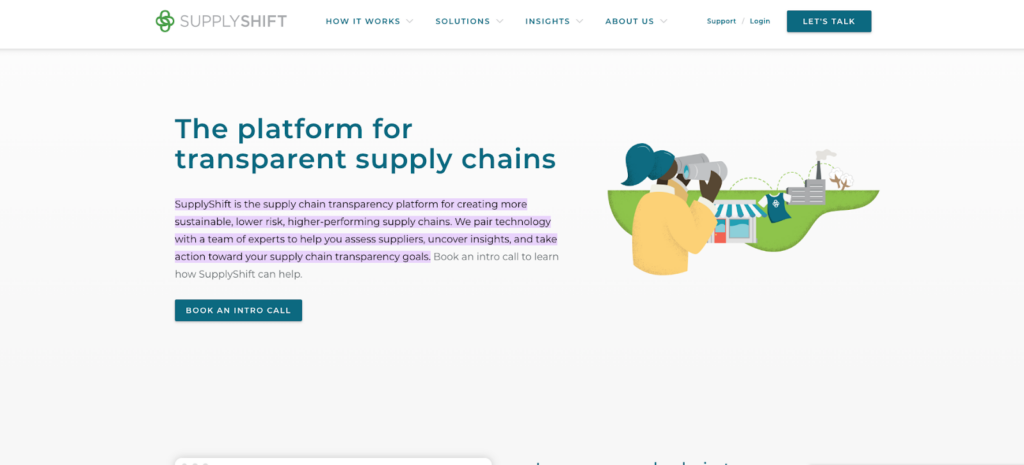
2. Transparency-One
This solution aims for in-depth, real-time supply chain analysis, creating opportunities for collaboration and information sharing across the different tiers. Features include mapping of suppliers and facilities “from raw material to finished goods,” information about certifications and assessments at any tier, and analytics on sustainability KPIs and supply chain risks.
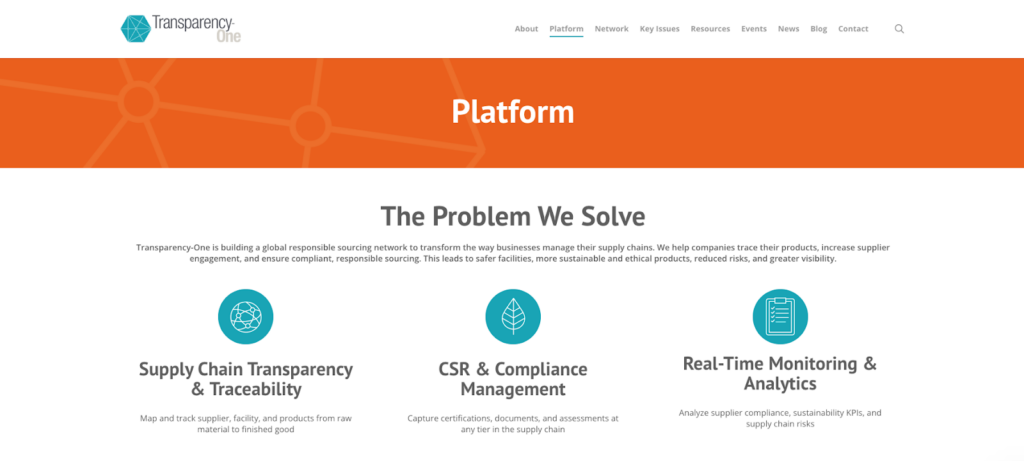
3. Authenticate
Focused on ESG (environmental, social, governance) standards and interfacing with certification schemes in sustainability or fair labor standards, Authenticate provides custom documentation and reporting tools for your business. In addition to mapping supply chains, you can manage inventory by sharing product specifications and resolving incidents by communicating across tiers.
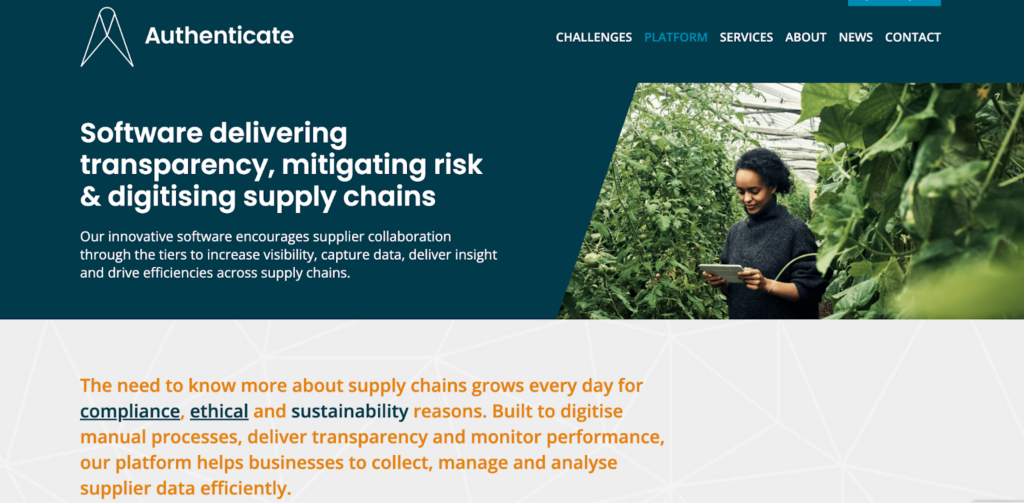
4. IBM Supply Chain Intelligence Suite
Built on AI, IBM’s platform enables automation of lower-tier supply chain processes to improve efficiency while also identifying and tracing product origins. Designed for businesses at scale, this tool can identify priority actions and forecast supply chain vulnerabilities.
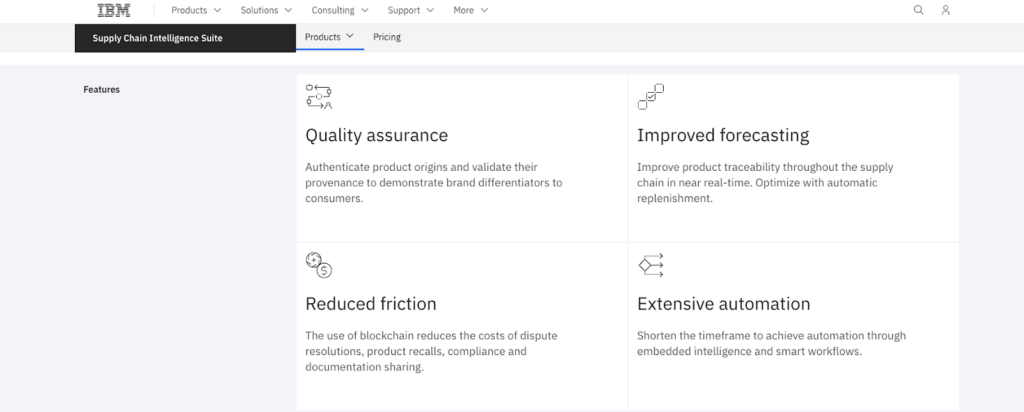
5. Open Supply Hub
The only open-data platform on the list, Open Supply Hub is aiming to make supply chain data “a free, public good” and has developed algorithms to create standardized, streamlined, and accessible information. Companies, organizations, and even factory groups can upload data where it is publicly available and can be used to analyze and map supply chain performance according to sustainability and human rights standards.
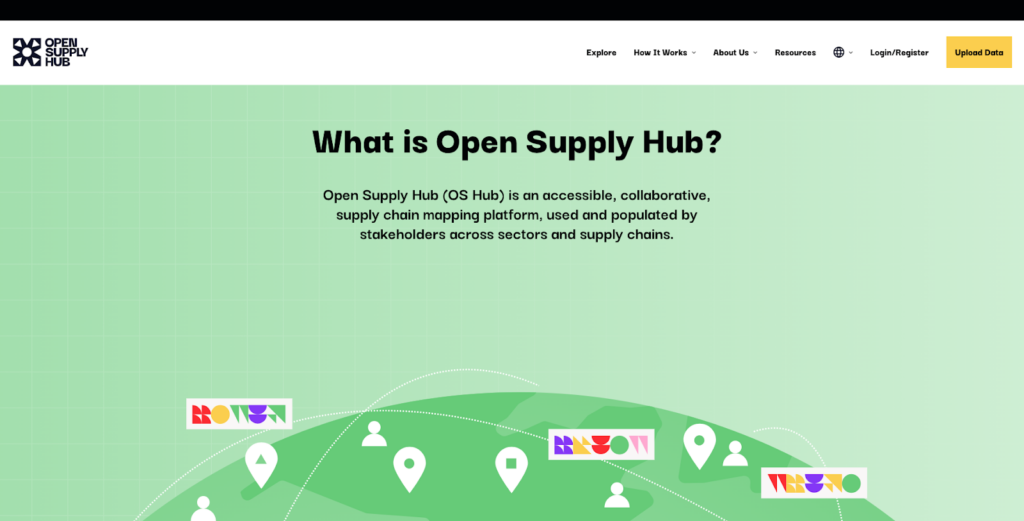
Authentication and verification codes
Think QR codes—these can verify that the product is not a counterfeit and that the appropriate process was followed to deliver to the end consumer. These secure codes are also used in information architecture and cryptography.
Radio-frequency identification (RFID) tags
These tiny, flexible chips can be embedded in paper or plastic. They have been used as inventory management tools and can update data as they move through the supply chain. RFID tags can track valuable stock, monitor the movement of vehicles, or be used for payment systems. There are certain technological hangups and ethical concerns to keep in mind, particularly when tags are used to track human movement or activity.
Blockchain
Originally created for Bitcoin transactions, this technology is showing potential in inventory management. Walmart has tested blockchain for tracking pork in China and produce in the U.S. One advantage is that the shared or decentralized ledger can be accessed by multiple points, and inconsistencies or errors can be quickly identified.
Why Increased Transparency Makes Good Business Sense
Increased transparency makes good sense for people and the environment while also providing major business values, such as:
- Compliance with regulations on reporting to set the stage for broader ESG practices
- Stronger appeal to outside companies for partnerships
- Improved talent attraction and retention
- Added appeal to conscious consumers
- Enhanced consumer trust
Inventory management is part of supply chain operations. When you have strong supply chain practices, inventory management can also be more organized and can incorporate concepts like the circular economy. This can help reduce unnecessary waste or dead stock.
Ultimately, continuous improvement is the game. Working through tiers of suppliers presents challenges in consistency. Without complete transparency, demands on, for example, third-tier suppliers generated by second-tier suppliers can cause unethical practices to meet production quotas. Building relationships throughout all stages of the supply chain process can ultimately increase resilience.
Tech like blockchain and RFID can help identify glitches or hitches in your system, such as inadequate product rotation on shelves or weak demand. Sensors can be especially useful for items that need to be transported in certain conditions (e.g., refrigerated perishables).
The groundwork in supply chain management will set the stage for strong environmental, social, and governance (ESG) practices. ESG essentially charts how your business's risks and opportunities align with considerations such as environmental impacts, social practices, and governing structures or ethical corporate behaviors.
Improving ESG measures brings its own set of benefits, such as more sustainable growth, reduction in the use of natural resources or energy, better employee motivation and satisfaction, and enhanced long-term growth planning.
With increased government action on this front, acting with ESG in mind can help to prevent regulatory fines or enforcement actions while piquing investment interests. In the United States, nearly half of the investors are interested in ESG—and awareness is growing.
Do The Work—The Transparent Supply Chain Will Work For You
When it comes to unraveling complicated supply chains, there are no easy answers. But that doesn’t mean incorporating transparency and sustainability practices in supply chain management is not worth it.
The benefits are clear, and the standards of practice are changing toward exposing vulnerabilities in supply chain operations. Open source and AI-enabled supply chain management platforms can help to analyze performance and identify vulnerabilities.
Stay in the loop on how you can continue to build such changes into your own business. Subscribe to our newsletter today!
More great ECM sustainability content:
- From Green To Mainstream: 6 Steps To Making Your Brand More Sustainable
- How Recommerce Helps Make A Difference For Your Brand And Customers
- The Sustainable Ecommerce Guide To Dead Stock
- 7 Examples Of Sustainable Ecommerce Packaging For Your Business
- What Is ESG Reporting: Trends, Statistics & Why It Matters


